Information Systems & Big Data Analysis: IT Solutions & Globalisation
VerifiedAdded on 2023/06/15
|10
|3289
|398
Report
AI Summary
This report provides an overview of information systems and big data analysis, focusing on IT solutions such as Moodle and Canvas. It discusses various systems like DSS, ESS, TPS, MIS, and KMS, along with examples of their applications. The report also examines the impact of globalization, particularly the role of IT in facilitating exchange of ideas, automation, and outsourcing. Furthermore, it defines digital infrastructure, outlining its advantages and disadvantages, and concludes with a discussion of risks associated with information system outsourcing and the critical role of IT infrastructure in digital transformation.
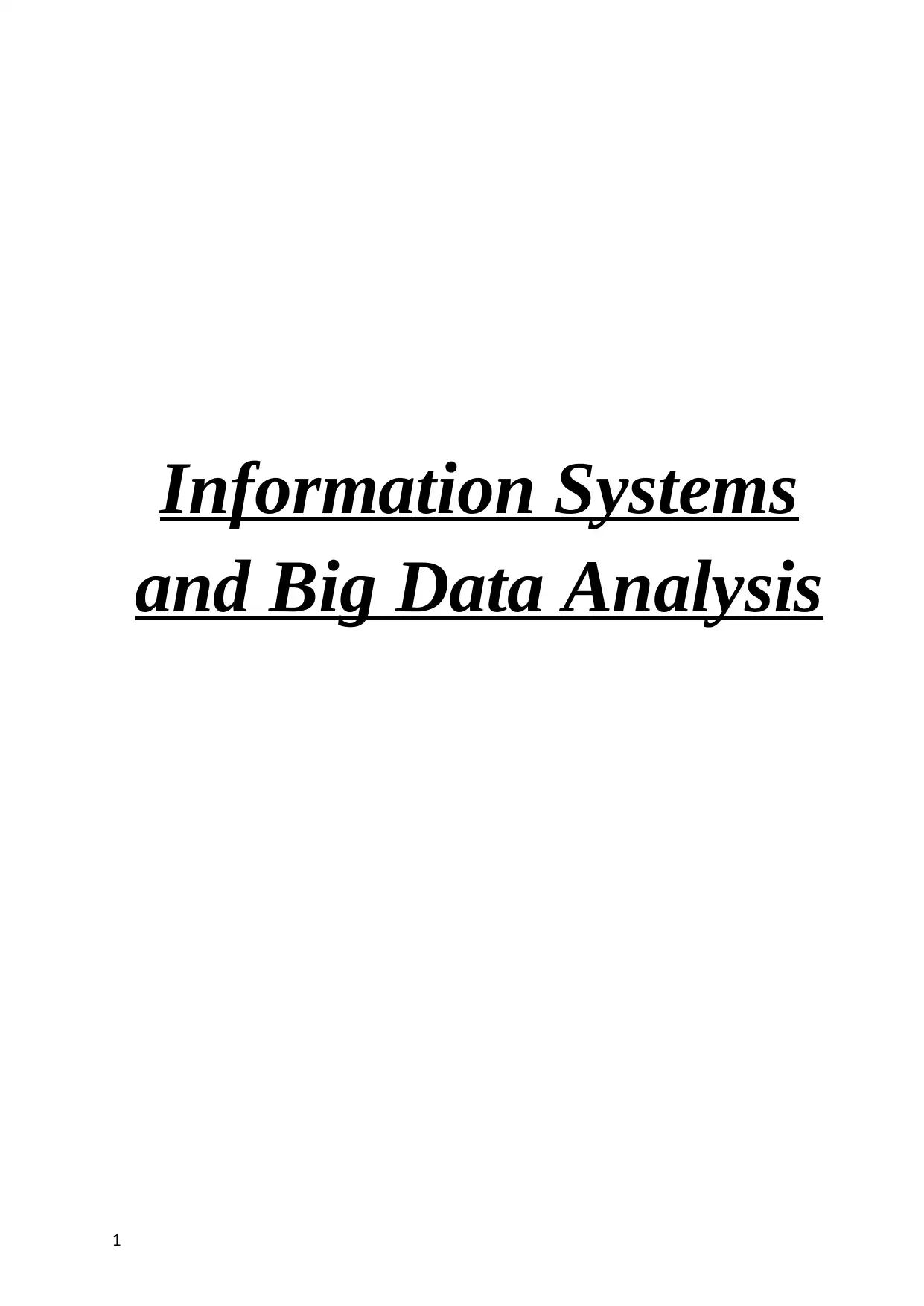
Information Systems
and Big Data Analysis
1
and Big Data Analysis
1
Paraphrase This Document
Need a fresh take? Get an instant paraphrase of this document with our AI Paraphraser
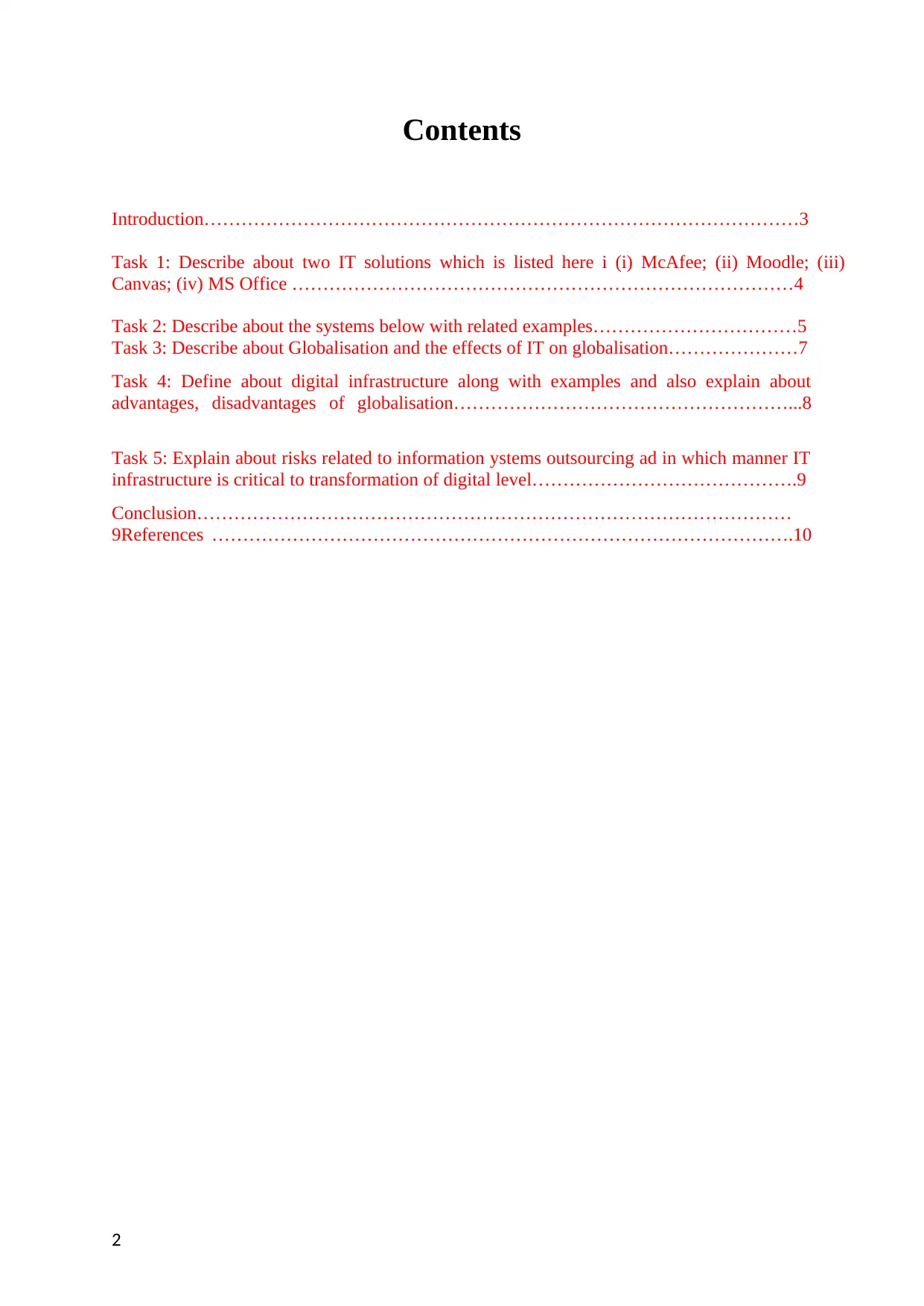
Contents
Introduction……………………………………………………………………………………3
Task 1: Describe about two IT solutions which is listed here i (i) McAfee; (ii) Moodle; (iii)
Canvas; (iv) MS Office ………………………………………………………………………4
Task 2: Describe about the systems below with related examples……………………………5
Task 3: Describe about Globalisation and the effects of IT on globalisation…………………7
Task 4: Define about digital infrastructure along with examples and also explain about
advantages, disadvantages of globalisation………………………………………………...8
Task 5: Explain about risks related to information ystems outsourcing ad in which manner IT
infrastructure is critical to transformation of digital level…………………………………….9
Conclusion……………………………………………………………………………………
9References ………………………………………………………………………………….10
2
Introduction……………………………………………………………………………………3
Task 1: Describe about two IT solutions which is listed here i (i) McAfee; (ii) Moodle; (iii)
Canvas; (iv) MS Office ………………………………………………………………………4
Task 2: Describe about the systems below with related examples……………………………5
Task 3: Describe about Globalisation and the effects of IT on globalisation…………………7
Task 4: Define about digital infrastructure along with examples and also explain about
advantages, disadvantages of globalisation………………………………………………...8
Task 5: Explain about risks related to information ystems outsourcing ad in which manner IT
infrastructure is critical to transformation of digital level…………………………………….9
Conclusion……………………………………………………………………………………
9References ………………………………………………………………………………….10
2
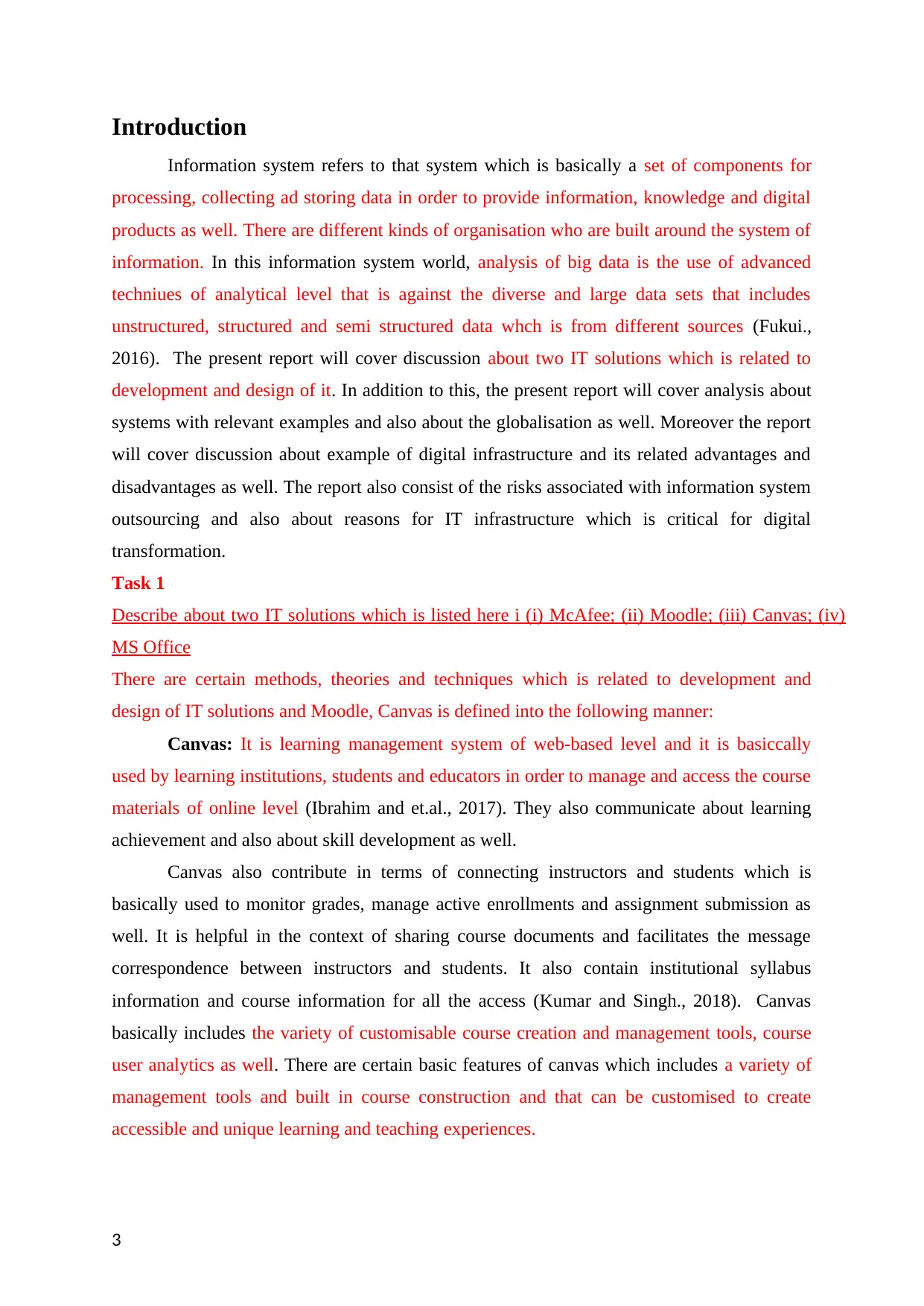
Introduction
Information system refers to that system which is basically a set of components for
processing, collecting ad storing data in order to provide information, knowledge and digital
products as well. There are different kinds of organisation who are built around the system of
information. In this information system world, analysis of big data is the use of advanced
techniues of analytical level that is against the diverse and large data sets that includes
unstructured, structured and semi structured data whch is from different sources (Fukui.,
2016). The present report will cover discussion about two IT solutions which is related to
development and design of it. In addition to this, the present report will cover analysis about
systems with relevant examples and also about the globalisation as well. Moreover the report
will cover discussion about example of digital infrastructure and its related advantages and
disadvantages as well. The report also consist of the risks associated with information system
outsourcing and also about reasons for IT infrastructure which is critical for digital
transformation.
Task 1
Describe about two IT solutions which is listed here i (i) McAfee; (ii) Moodle; (iii) Canvas; (iv)
MS Office
There are certain methods, theories and techniques which is related to development and
design of IT solutions and Moodle, Canvas is defined into the following manner:
Canvas: It is learning management system of web-based level and it is basiccally
used by learning institutions, students and educators in order to manage and access the course
materials of online level (Ibrahim and et.al., 2017). They also communicate about learning
achievement and also about skill development as well.
Canvas also contribute in terms of connecting instructors and students which is
basically used to monitor grades, manage active enrollments and assignment submission as
well. It is helpful in the context of sharing course documents and facilitates the message
correspondence between instructors and students. It also contain institutional syllabus
information and course information for all the access (Kumar and Singh., 2018). Canvas
basically includes the variety of customisable course creation and management tools, course
user analytics as well. There are certain basic features of canvas which includes a variety of
management tools and built in course construction and that can be customised to create
accessible and unique learning and teaching experiences.
3
Information system refers to that system which is basically a set of components for
processing, collecting ad storing data in order to provide information, knowledge and digital
products as well. There are different kinds of organisation who are built around the system of
information. In this information system world, analysis of big data is the use of advanced
techniues of analytical level that is against the diverse and large data sets that includes
unstructured, structured and semi structured data whch is from different sources (Fukui.,
2016). The present report will cover discussion about two IT solutions which is related to
development and design of it. In addition to this, the present report will cover analysis about
systems with relevant examples and also about the globalisation as well. Moreover the report
will cover discussion about example of digital infrastructure and its related advantages and
disadvantages as well. The report also consist of the risks associated with information system
outsourcing and also about reasons for IT infrastructure which is critical for digital
transformation.
Task 1
Describe about two IT solutions which is listed here i (i) McAfee; (ii) Moodle; (iii) Canvas; (iv)
MS Office
There are certain methods, theories and techniques which is related to development and
design of IT solutions and Moodle, Canvas is defined into the following manner:
Canvas: It is learning management system of web-based level and it is basiccally
used by learning institutions, students and educators in order to manage and access the course
materials of online level (Ibrahim and et.al., 2017). They also communicate about learning
achievement and also about skill development as well.
Canvas also contribute in terms of connecting instructors and students which is
basically used to monitor grades, manage active enrollments and assignment submission as
well. It is helpful in the context of sharing course documents and facilitates the message
correspondence between instructors and students. It also contain institutional syllabus
information and course information for all the access (Kumar and Singh., 2018). Canvas
basically includes the variety of customisable course creation and management tools, course
user analytics as well. There are certain basic features of canvas which includes a variety of
management tools and built in course construction and that can be customised to create
accessible and unique learning and teaching experiences.
3
⊘ This is a preview!⊘
Do you want full access?
Subscribe today to unlock all pages.

Trusted by 1+ million students worldwide
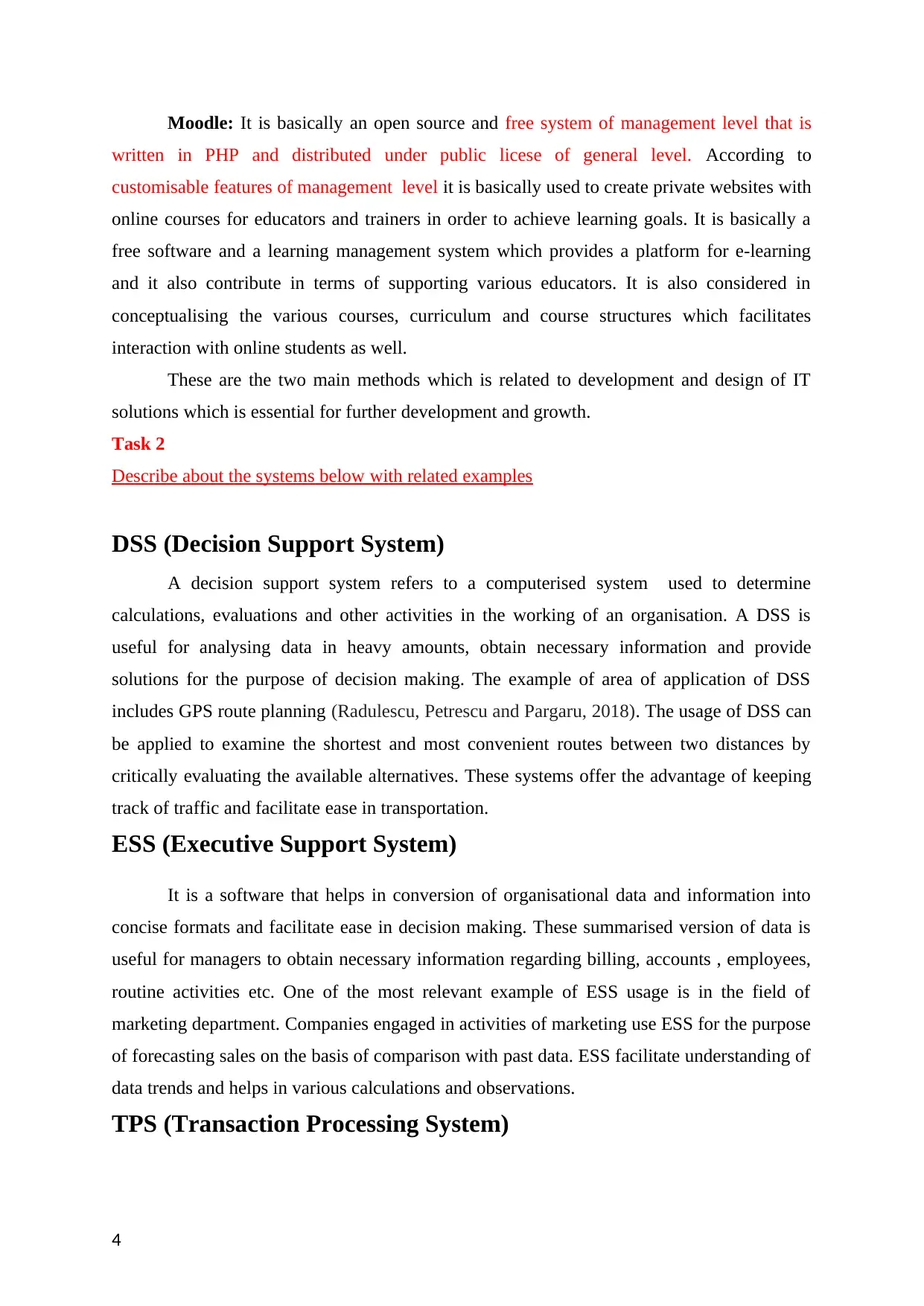
Moodle: It is basically an open source and free system of management level that is
written in PHP and distributed under public licese of general level. According to
customisable features of management level it is basically used to create private websites with
online courses for educators and trainers in order to achieve learning goals. It is basically a
free software and a learning management system which provides a platform for e-learning
and it also contribute in terms of supporting various educators. It is also considered in
conceptualising the various courses, curriculum and course structures which facilitates
interaction with online students as well.
These are the two main methods which is related to development and design of IT
solutions which is essential for further development and growth.
Task 2
Describe about the systems below with related examples
DSS (Decision Support System)
A decision support system refers to a computerised system used to determine
calculations, evaluations and other activities in the working of an organisation. A DSS is
useful for analysing data in heavy amounts, obtain necessary information and provide
solutions for the purpose of decision making. The example of area of application of DSS
includes GPS route planning (Radulescu, Petrescu and Pargaru, 2018). The usage of DSS can
be applied to examine the shortest and most convenient routes between two distances by
critically evaluating the available alternatives. These systems offer the advantage of keeping
track of traffic and facilitate ease in transportation.
ESS (Executive Support System)
It is a software that helps in conversion of organisational data and information into
concise formats and facilitate ease in decision making. These summarised version of data is
useful for managers to obtain necessary information regarding billing, accounts , employees,
routine activities etc. One of the most relevant example of ESS usage is in the field of
marketing department. Companies engaged in activities of marketing use ESS for the purpose
of forecasting sales on the basis of comparison with past data. ESS facilitate understanding of
data trends and helps in various calculations and observations.
TPS (Transaction Processing System)
4
written in PHP and distributed under public licese of general level. According to
customisable features of management level it is basically used to create private websites with
online courses for educators and trainers in order to achieve learning goals. It is basically a
free software and a learning management system which provides a platform for e-learning
and it also contribute in terms of supporting various educators. It is also considered in
conceptualising the various courses, curriculum and course structures which facilitates
interaction with online students as well.
These are the two main methods which is related to development and design of IT
solutions which is essential for further development and growth.
Task 2
Describe about the systems below with related examples
DSS (Decision Support System)
A decision support system refers to a computerised system used to determine
calculations, evaluations and other activities in the working of an organisation. A DSS is
useful for analysing data in heavy amounts, obtain necessary information and provide
solutions for the purpose of decision making. The example of area of application of DSS
includes GPS route planning (Radulescu, Petrescu and Pargaru, 2018). The usage of DSS can
be applied to examine the shortest and most convenient routes between two distances by
critically evaluating the available alternatives. These systems offer the advantage of keeping
track of traffic and facilitate ease in transportation.
ESS (Executive Support System)
It is a software that helps in conversion of organisational data and information into
concise formats and facilitate ease in decision making. These summarised version of data is
useful for managers to obtain necessary information regarding billing, accounts , employees,
routine activities etc. One of the most relevant example of ESS usage is in the field of
marketing department. Companies engaged in activities of marketing use ESS for the purpose
of forecasting sales on the basis of comparison with past data. ESS facilitate understanding of
data trends and helps in various calculations and observations.
TPS (Transaction Processing System)
4
Paraphrase This Document
Need a fresh take? Get an instant paraphrase of this document with our AI Paraphraser
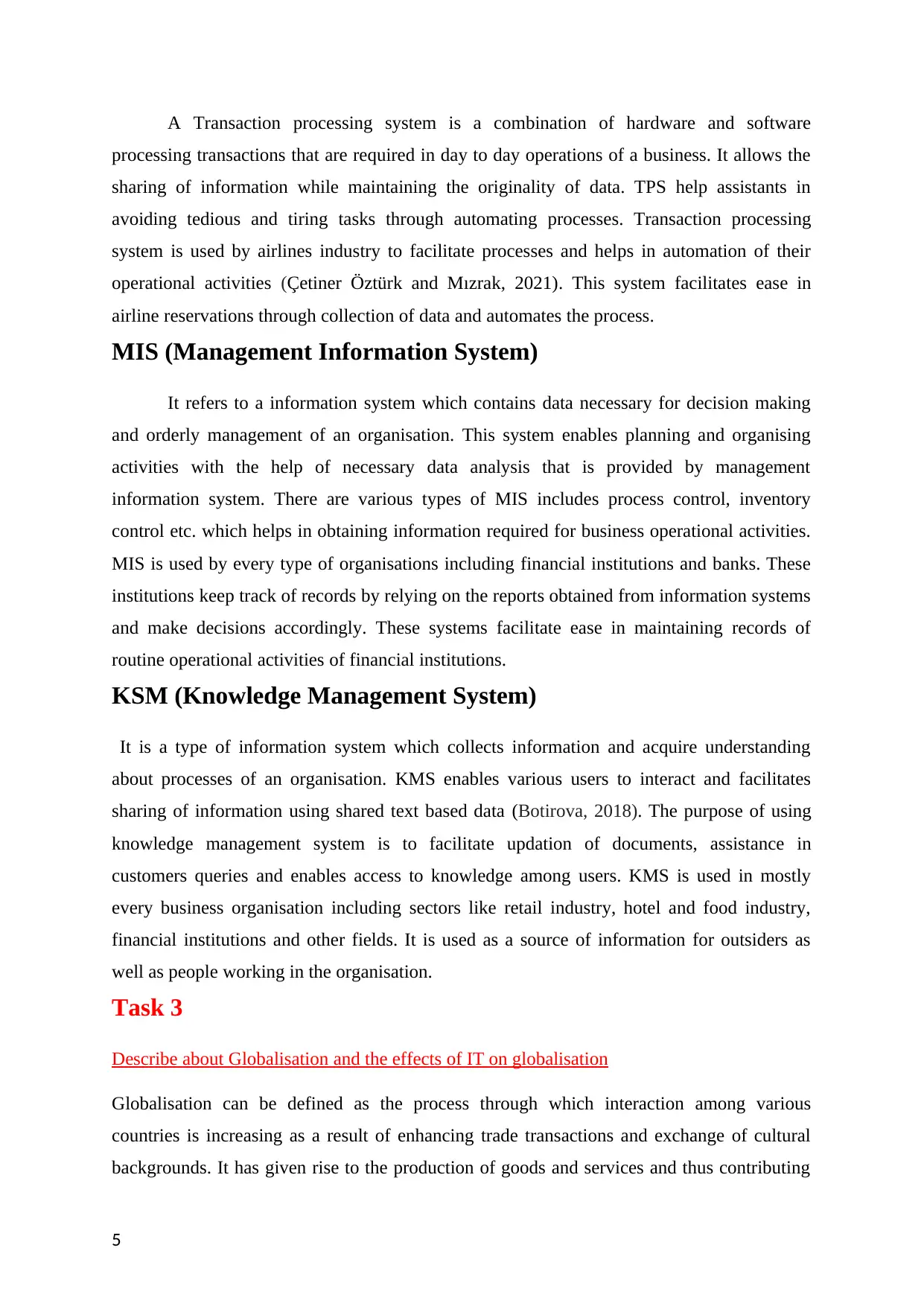
A Transaction processing system is a combination of hardware and software
processing transactions that are required in day to day operations of a business. It allows the
sharing of information while maintaining the originality of data. TPS help assistants in
avoiding tedious and tiring tasks through automating processes. Transaction processing
system is used by airlines industry to facilitate processes and helps in automation of their
operational activities (Çetiner Öztürk and Mızrak, 2021). This system facilitates ease in
airline reservations through collection of data and automates the process.
MIS (Management Information System)
It refers to a information system which contains data necessary for decision making
and orderly management of an organisation. This system enables planning and organising
activities with the help of necessary data analysis that is provided by management
information system. There are various types of MIS includes process control, inventory
control etc. which helps in obtaining information required for business operational activities.
MIS is used by every type of organisations including financial institutions and banks. These
institutions keep track of records by relying on the reports obtained from information systems
and make decisions accordingly. These systems facilitate ease in maintaining records of
routine operational activities of financial institutions.
KSM (Knowledge Management System)
It is a type of information system which collects information and acquire understanding
about processes of an organisation. KMS enables various users to interact and facilitates
sharing of information using shared text based data (Botirova, 2018). The purpose of using
knowledge management system is to facilitate updation of documents, assistance in
customers queries and enables access to knowledge among users. KMS is used in mostly
every business organisation including sectors like retail industry, hotel and food industry,
financial institutions and other fields. It is used as a source of information for outsiders as
well as people working in the organisation.
Task 3
Describe about Globalisation and the effects of IT on globalisation
Globalisation can be defined as the process through which interaction among various
countries is increasing as a result of enhancing trade transactions and exchange of cultural
backgrounds. It has given rise to the production of goods and services and thus contributing
5
processing transactions that are required in day to day operations of a business. It allows the
sharing of information while maintaining the originality of data. TPS help assistants in
avoiding tedious and tiring tasks through automating processes. Transaction processing
system is used by airlines industry to facilitate processes and helps in automation of their
operational activities (Çetiner Öztürk and Mızrak, 2021). This system facilitates ease in
airline reservations through collection of data and automates the process.
MIS (Management Information System)
It refers to a information system which contains data necessary for decision making
and orderly management of an organisation. This system enables planning and organising
activities with the help of necessary data analysis that is provided by management
information system. There are various types of MIS includes process control, inventory
control etc. which helps in obtaining information required for business operational activities.
MIS is used by every type of organisations including financial institutions and banks. These
institutions keep track of records by relying on the reports obtained from information systems
and make decisions accordingly. These systems facilitate ease in maintaining records of
routine operational activities of financial institutions.
KSM (Knowledge Management System)
It is a type of information system which collects information and acquire understanding
about processes of an organisation. KMS enables various users to interact and facilitates
sharing of information using shared text based data (Botirova, 2018). The purpose of using
knowledge management system is to facilitate updation of documents, assistance in
customers queries and enables access to knowledge among users. KMS is used in mostly
every business organisation including sectors like retail industry, hotel and food industry,
financial institutions and other fields. It is used as a source of information for outsiders as
well as people working in the organisation.
Task 3
Describe about Globalisation and the effects of IT on globalisation
Globalisation can be defined as the process through which interaction among various
countries is increasing as a result of enhancing trade transactions and exchange of cultural
backgrounds. It has given rise to the production of goods and services and thus contributing
5
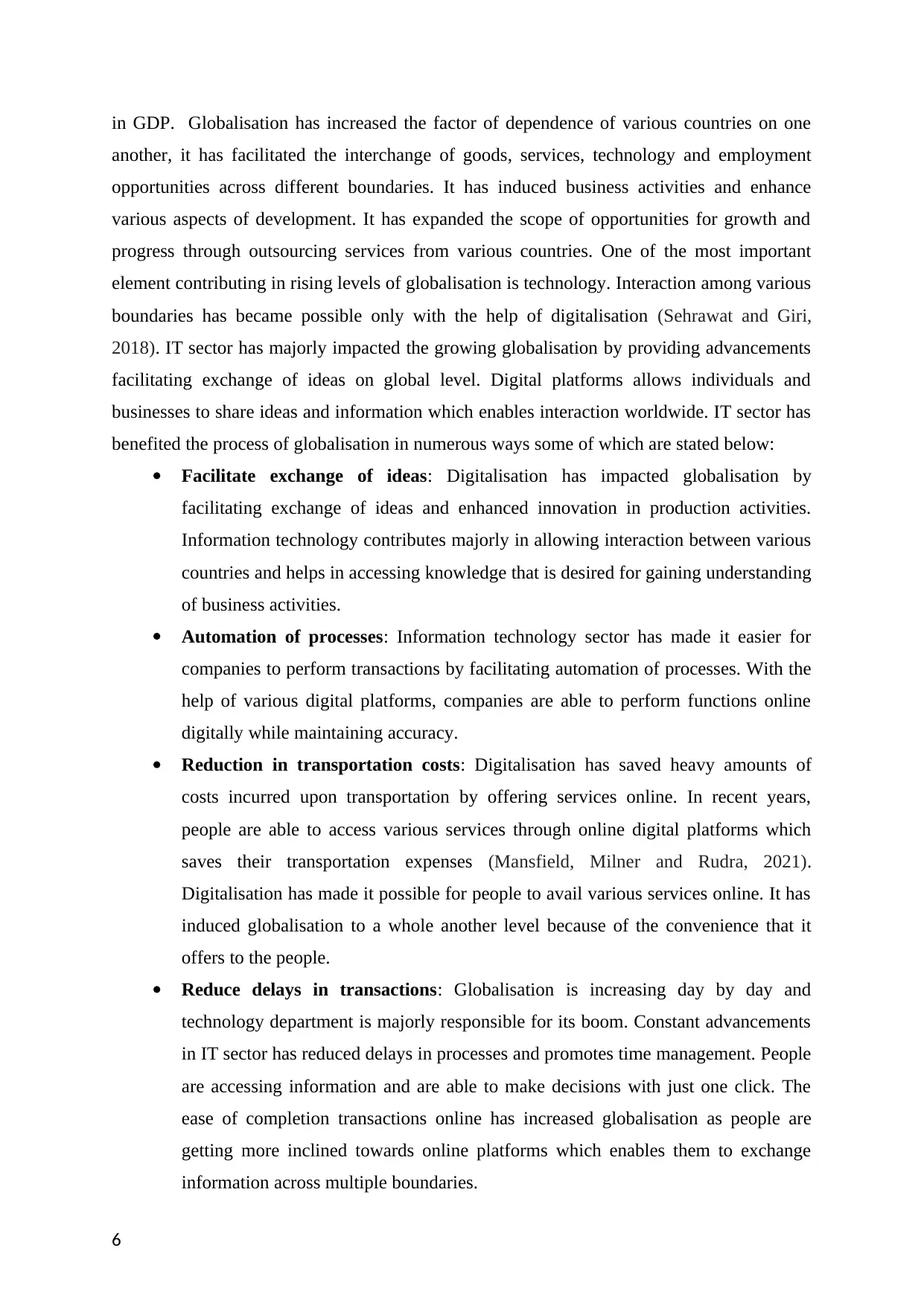
in GDP. Globalisation has increased the factor of dependence of various countries on one
another, it has facilitated the interchange of goods, services, technology and employment
opportunities across different boundaries. It has induced business activities and enhance
various aspects of development. It has expanded the scope of opportunities for growth and
progress through outsourcing services from various countries. One of the most important
element contributing in rising levels of globalisation is technology. Interaction among various
boundaries has became possible only with the help of digitalisation (Sehrawat and Giri,
2018). IT sector has majorly impacted the growing globalisation by providing advancements
facilitating exchange of ideas on global level. Digital platforms allows individuals and
businesses to share ideas and information which enables interaction worldwide. IT sector has
benefited the process of globalisation in numerous ways some of which are stated below:
Facilitate exchange of ideas: Digitalisation has impacted globalisation by
facilitating exchange of ideas and enhanced innovation in production activities.
Information technology contributes majorly in allowing interaction between various
countries and helps in accessing knowledge that is desired for gaining understanding
of business activities.
Automation of processes: Information technology sector has made it easier for
companies to perform transactions by facilitating automation of processes. With the
help of various digital platforms, companies are able to perform functions online
digitally while maintaining accuracy.
Reduction in transportation costs: Digitalisation has saved heavy amounts of
costs incurred upon transportation by offering services online. In recent years,
people are able to access various services through online digital platforms which
saves their transportation expenses (Mansfield, Milner and Rudra, 2021).
Digitalisation has made it possible for people to avail various services online. It has
induced globalisation to a whole another level because of the convenience that it
offers to the people.
Reduce delays in transactions: Globalisation is increasing day by day and
technology department is majorly responsible for its boom. Constant advancements
in IT sector has reduced delays in processes and promotes time management. People
are accessing information and are able to make decisions with just one click. The
ease of completion transactions online has increased globalisation as people are
getting more inclined towards online platforms which enables them to exchange
information across multiple boundaries.
6
another, it has facilitated the interchange of goods, services, technology and employment
opportunities across different boundaries. It has induced business activities and enhance
various aspects of development. It has expanded the scope of opportunities for growth and
progress through outsourcing services from various countries. One of the most important
element contributing in rising levels of globalisation is technology. Interaction among various
boundaries has became possible only with the help of digitalisation (Sehrawat and Giri,
2018). IT sector has majorly impacted the growing globalisation by providing advancements
facilitating exchange of ideas on global level. Digital platforms allows individuals and
businesses to share ideas and information which enables interaction worldwide. IT sector has
benefited the process of globalisation in numerous ways some of which are stated below:
Facilitate exchange of ideas: Digitalisation has impacted globalisation by
facilitating exchange of ideas and enhanced innovation in production activities.
Information technology contributes majorly in allowing interaction between various
countries and helps in accessing knowledge that is desired for gaining understanding
of business activities.
Automation of processes: Information technology sector has made it easier for
companies to perform transactions by facilitating automation of processes. With the
help of various digital platforms, companies are able to perform functions online
digitally while maintaining accuracy.
Reduction in transportation costs: Digitalisation has saved heavy amounts of
costs incurred upon transportation by offering services online. In recent years,
people are able to access various services through online digital platforms which
saves their transportation expenses (Mansfield, Milner and Rudra, 2021).
Digitalisation has made it possible for people to avail various services online. It has
induced globalisation to a whole another level because of the convenience that it
offers to the people.
Reduce delays in transactions: Globalisation is increasing day by day and
technology department is majorly responsible for its boom. Constant advancements
in IT sector has reduced delays in processes and promotes time management. People
are accessing information and are able to make decisions with just one click. The
ease of completion transactions online has increased globalisation as people are
getting more inclined towards online platforms which enables them to exchange
information across multiple boundaries.
6
⊘ This is a preview!⊘
Do you want full access?
Subscribe today to unlock all pages.

Trusted by 1+ million students worldwide

Enables outsourcing: Technological advancements are being outsourcing to the
developing countries and where people are willing to work at low wages. It enables
high tech countries to procure cheap labour from developing countries (Huzenko,
2019).
Exchange of innovation: Globalisation is driven by the constant growth of
innovative ideas and creative inventions. Digitalisation contributes significantly in
introduction of innovative ideas every now and then, it enables quick research and
offers ideas for great inventions. IT sector has impacted globalisation by
implementation of innovative ideas which foster advanced inventions and facilitate
export and import of these inventions
Task 4
Define about digital infrastructure along with examples and also explain about advantages,
disadvantages of globalisation
Digital infrastructure basically refers to those technologies on digital level that provides the
foundation for organisation information technology and operations as well. Digital
infrastructure is important because it basically drives all the aspects of smart and future cities
and also act as key component of societies and economies as well(Lin and et.al., 2016). It is
also important with this reason that they help the company in becoming more smarter and
also enables to provide high quality experiences in order to keep up with customer demands
and employee productivity as well. There are certain examples of digital infrastructure which
basically includes internet backbone, broadband as well.
There are certain advantages and disadvantages of digital infrastructure and it is
defined into the following manner:
Advantages of Digital Infrastructure: Digital infrastructure allows that it connects
people and places into appropriate manner. They also help in terms of improving productivity
and also increases the economic growth. In this modern and technological world, the
businesses efficiency get increased through technological innovation and ideas as well(Pal, .,
2019). It also contribute in terms of improving the sustainability level within the
organisation. The main advantage of digital infrastructure is that they are always ready to
adopt new technologies into positive manner for further growth and development of business.
Disadvantages of Digital Infrastructure: Digital infrastructure does not ensure
about the data security and it also sometimes leads towards terrorism and crime as well.
7
developing countries and where people are willing to work at low wages. It enables
high tech countries to procure cheap labour from developing countries (Huzenko,
2019).
Exchange of innovation: Globalisation is driven by the constant growth of
innovative ideas and creative inventions. Digitalisation contributes significantly in
introduction of innovative ideas every now and then, it enables quick research and
offers ideas for great inventions. IT sector has impacted globalisation by
implementation of innovative ideas which foster advanced inventions and facilitate
export and import of these inventions
Task 4
Define about digital infrastructure along with examples and also explain about advantages,
disadvantages of globalisation
Digital infrastructure basically refers to those technologies on digital level that provides the
foundation for organisation information technology and operations as well. Digital
infrastructure is important because it basically drives all the aspects of smart and future cities
and also act as key component of societies and economies as well(Lin and et.al., 2016). It is
also important with this reason that they help the company in becoming more smarter and
also enables to provide high quality experiences in order to keep up with customer demands
and employee productivity as well. There are certain examples of digital infrastructure which
basically includes internet backbone, broadband as well.
There are certain advantages and disadvantages of digital infrastructure and it is
defined into the following manner:
Advantages of Digital Infrastructure: Digital infrastructure allows that it connects
people and places into appropriate manner. They also help in terms of improving productivity
and also increases the economic growth. In this modern and technological world, the
businesses efficiency get increased through technological innovation and ideas as well(Pal, .,
2019). It also contribute in terms of improving the sustainability level within the
organisation. The main advantage of digital infrastructure is that they are always ready to
adopt new technologies into positive manner for further growth and development of business.
Disadvantages of Digital Infrastructure: Digital infrastructure does not ensure
about the data security and it also sometimes leads towards terrorism and crime as well.
7
Paraphrase This Document
Need a fresh take? Get an instant paraphrase of this document with our AI Paraphraser
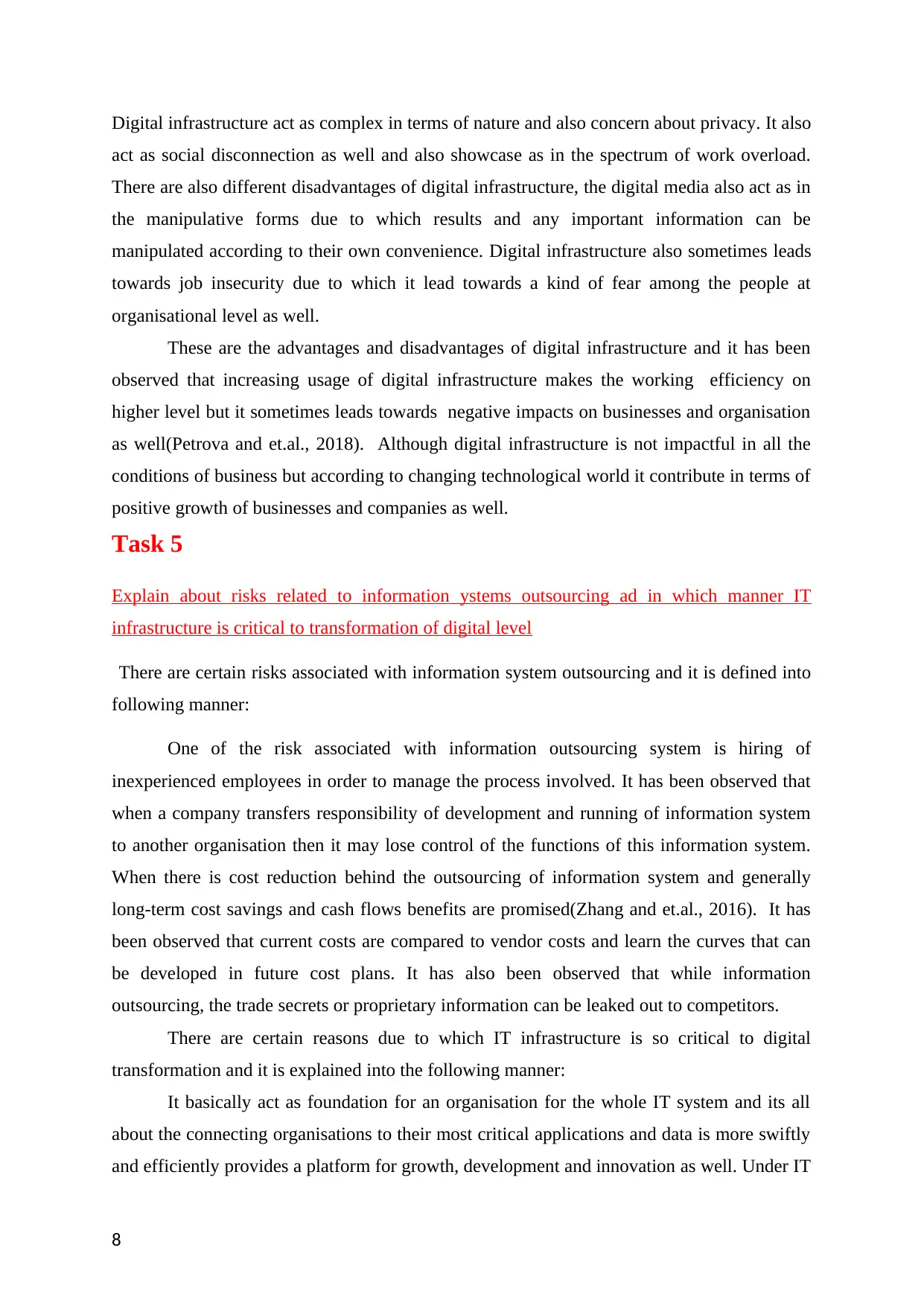
Digital infrastructure act as complex in terms of nature and also concern about privacy. It also
act as social disconnection as well and also showcase as in the spectrum of work overload.
There are also different disadvantages of digital infrastructure, the digital media also act as in
the manipulative forms due to which results and any important information can be
manipulated according to their own convenience. Digital infrastructure also sometimes leads
towards job insecurity due to which it lead towards a kind of fear among the people at
organisational level as well.
These are the advantages and disadvantages of digital infrastructure and it has been
observed that increasing usage of digital infrastructure makes the working efficiency on
higher level but it sometimes leads towards negative impacts on businesses and organisation
as well(Petrova and et.al., 2018). Although digital infrastructure is not impactful in all the
conditions of business but according to changing technological world it contribute in terms of
positive growth of businesses and companies as well.
Task 5
Explain about risks related to information ystems outsourcing ad in which manner IT
infrastructure is critical to transformation of digital level
There are certain risks associated with information system outsourcing and it is defined into
following manner:
One of the risk associated with information outsourcing system is hiring of
inexperienced employees in order to manage the process involved. It has been observed that
when a company transfers responsibility of development and running of information system
to another organisation then it may lose control of the functions of this information system.
When there is cost reduction behind the outsourcing of information system and generally
long-term cost savings and cash flows benefits are promised(Zhang and et.al., 2016). It has
been observed that current costs are compared to vendor costs and learn the curves that can
be developed in future cost plans. It has also been observed that while information
outsourcing, the trade secrets or proprietary information can be leaked out to competitors.
There are certain reasons due to which IT infrastructure is so critical to digital
transformation and it is explained into the following manner:
It basically act as foundation for an organisation for the whole IT system and its all
about the connecting organisations to their most critical applications and data is more swiftly
and efficiently provides a platform for growth, development and innovation as well. Under IT
8
act as social disconnection as well and also showcase as in the spectrum of work overload.
There are also different disadvantages of digital infrastructure, the digital media also act as in
the manipulative forms due to which results and any important information can be
manipulated according to their own convenience. Digital infrastructure also sometimes leads
towards job insecurity due to which it lead towards a kind of fear among the people at
organisational level as well.
These are the advantages and disadvantages of digital infrastructure and it has been
observed that increasing usage of digital infrastructure makes the working efficiency on
higher level but it sometimes leads towards negative impacts on businesses and organisation
as well(Petrova and et.al., 2018). Although digital infrastructure is not impactful in all the
conditions of business but according to changing technological world it contribute in terms of
positive growth of businesses and companies as well.
Task 5
Explain about risks related to information ystems outsourcing ad in which manner IT
infrastructure is critical to transformation of digital level
There are certain risks associated with information system outsourcing and it is defined into
following manner:
One of the risk associated with information outsourcing system is hiring of
inexperienced employees in order to manage the process involved. It has been observed that
when a company transfers responsibility of development and running of information system
to another organisation then it may lose control of the functions of this information system.
When there is cost reduction behind the outsourcing of information system and generally
long-term cost savings and cash flows benefits are promised(Zhang and et.al., 2016). It has
been observed that current costs are compared to vendor costs and learn the curves that can
be developed in future cost plans. It has also been observed that while information
outsourcing, the trade secrets or proprietary information can be leaked out to competitors.
There are certain reasons due to which IT infrastructure is so critical to digital
transformation and it is explained into the following manner:
It basically act as foundation for an organisation for the whole IT system and its all
about the connecting organisations to their most critical applications and data is more swiftly
and efficiently provides a platform for growth, development and innovation as well. Under IT
8
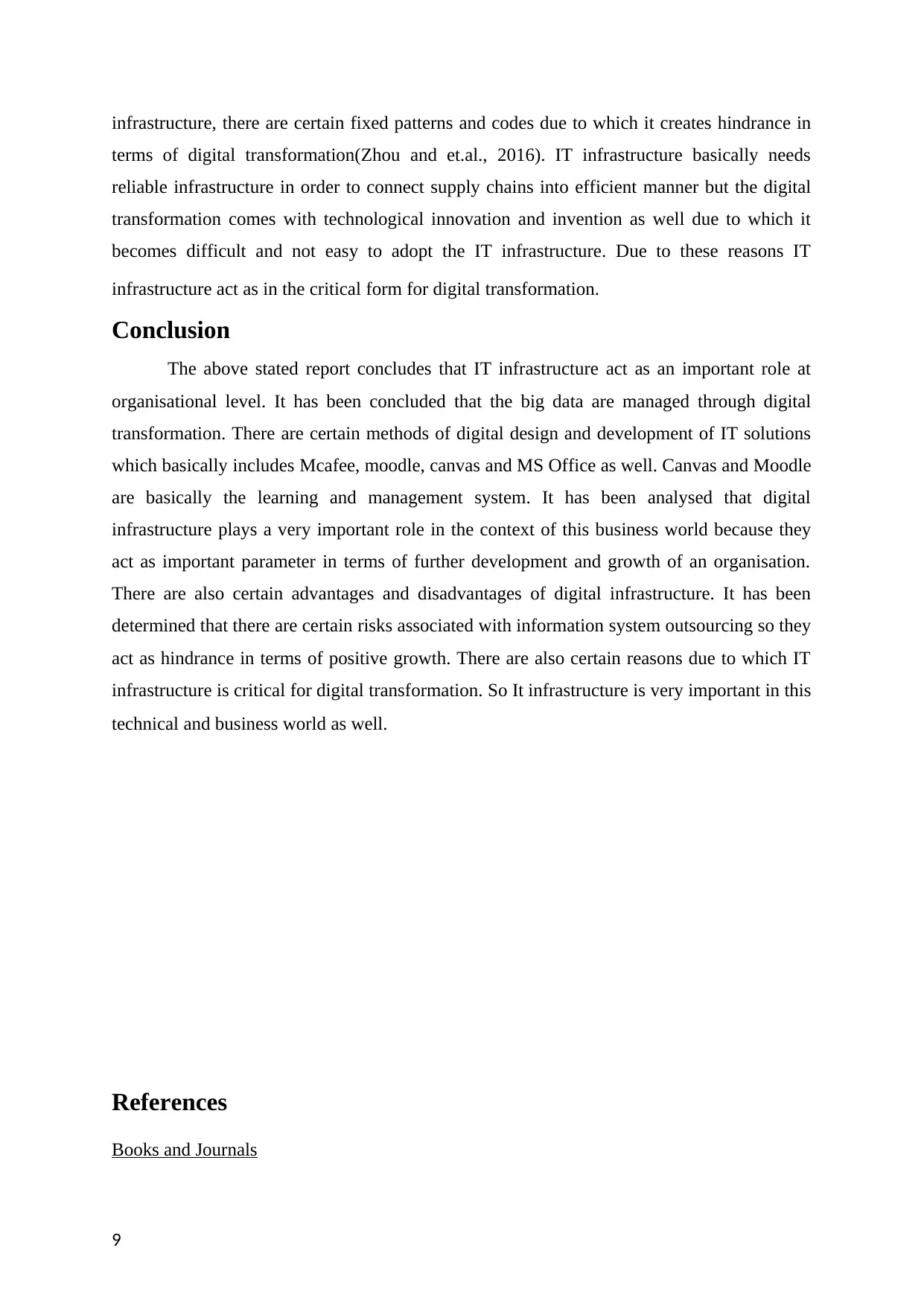
infrastructure, there are certain fixed patterns and codes due to which it creates hindrance in
terms of digital transformation(Zhou and et.al., 2016). IT infrastructure basically needs
reliable infrastructure in order to connect supply chains into efficient manner but the digital
transformation comes with technological innovation and invention as well due to which it
becomes difficult and not easy to adopt the IT infrastructure. Due to these reasons IT
infrastructure act as in the critical form for digital transformation.
Conclusion
The above stated report concludes that IT infrastructure act as an important role at
organisational level. It has been concluded that the big data are managed through digital
transformation. There are certain methods of digital design and development of IT solutions
which basically includes Mcafee, moodle, canvas and MS Office as well. Canvas and Moodle
are basically the learning and management system. It has been analysed that digital
infrastructure plays a very important role in the context of this business world because they
act as important parameter in terms of further development and growth of an organisation.
There are also certain advantages and disadvantages of digital infrastructure. It has been
determined that there are certain risks associated with information system outsourcing so they
act as hindrance in terms of positive growth. There are also certain reasons due to which IT
infrastructure is critical for digital transformation. So It infrastructure is very important in this
technical and business world as well.
References
Books and Journals
9
terms of digital transformation(Zhou and et.al., 2016). IT infrastructure basically needs
reliable infrastructure in order to connect supply chains into efficient manner but the digital
transformation comes with technological innovation and invention as well due to which it
becomes difficult and not easy to adopt the IT infrastructure. Due to these reasons IT
infrastructure act as in the critical form for digital transformation.
Conclusion
The above stated report concludes that IT infrastructure act as an important role at
organisational level. It has been concluded that the big data are managed through digital
transformation. There are certain methods of digital design and development of IT solutions
which basically includes Mcafee, moodle, canvas and MS Office as well. Canvas and Moodle
are basically the learning and management system. It has been analysed that digital
infrastructure plays a very important role in the context of this business world because they
act as important parameter in terms of further development and growth of an organisation.
There are also certain advantages and disadvantages of digital infrastructure. It has been
determined that there are certain risks associated with information system outsourcing so they
act as hindrance in terms of positive growth. There are also certain reasons due to which IT
infrastructure is critical for digital transformation. So It infrastructure is very important in this
technical and business world as well.
References
Books and Journals
9
⊘ This is a preview!⊘
Do you want full access?
Subscribe today to unlock all pages.

Trusted by 1+ million students worldwide
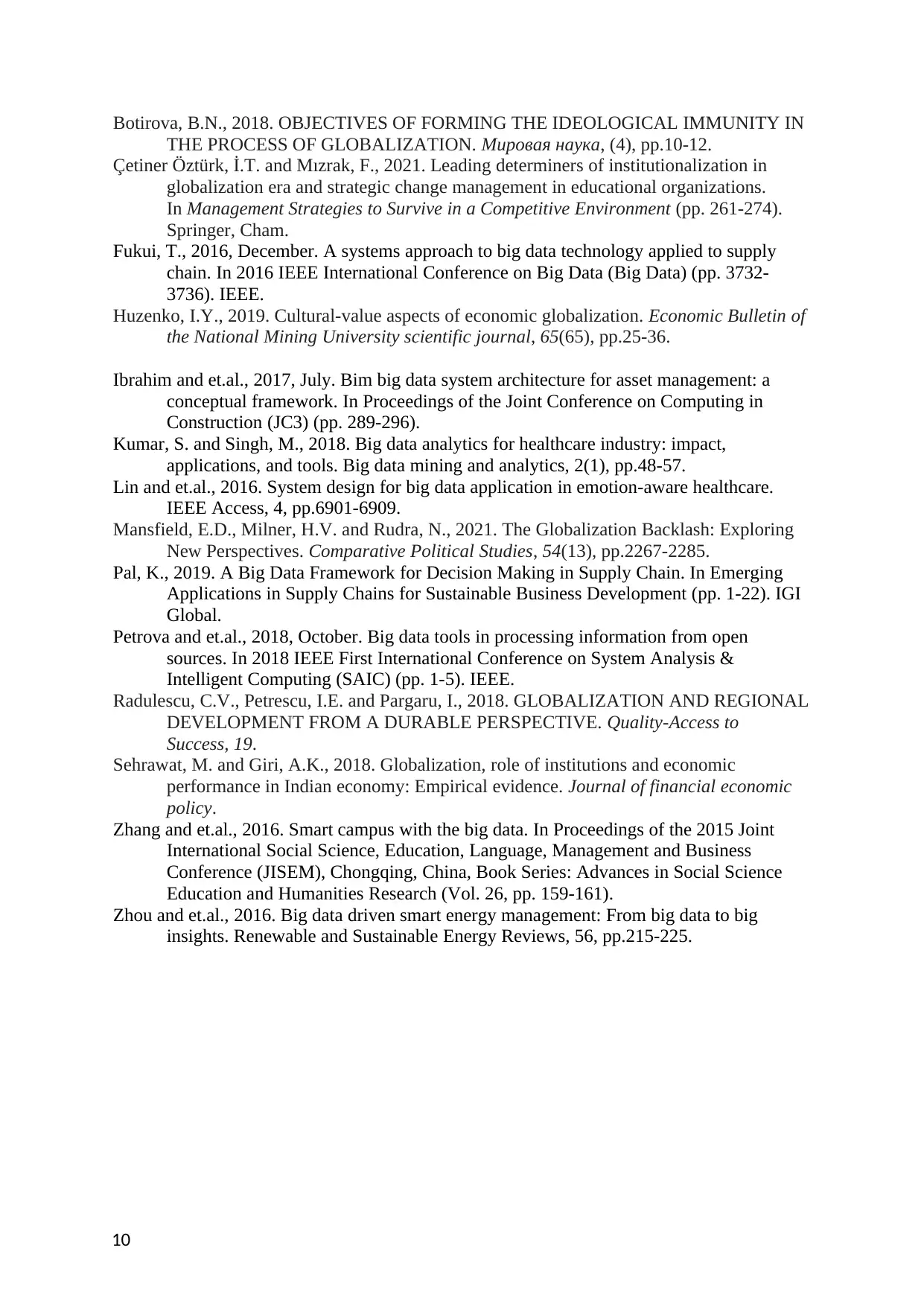
Botirova, B.N., 2018. OBJECTIVES OF FORMING THE IDEOLOGICAL IMMUNITY IN
THE PROCESS OF GLOBALIZATION. Мировая наука, (4), pp.10-12.
Çetiner Öztürk, İ.T. and Mızrak, F., 2021. Leading determiners of institutionalization in
globalization era and strategic change management in educational organizations.
In Management Strategies to Survive in a Competitive Environment (pp. 261-274).
Springer, Cham.
Fukui, T., 2016, December. A systems approach to big data technology applied to supply
chain. In 2016 IEEE International Conference on Big Data (Big Data) (pp. 3732-
3736). IEEE.
Huzenko, I.Y., 2019. Cultural-value aspects of economic globalization. Economic Bulletin of
the National Mining University scientific journal, 65(65), pp.25-36.
Ibrahim and et.al., 2017, July. Bim big data system architecture for asset management: a
conceptual framework. In Proceedings of the Joint Conference on Computing in
Construction (JC3) (pp. 289-296).
Kumar, S. and Singh, M., 2018. Big data analytics for healthcare industry: impact,
applications, and tools. Big data mining and analytics, 2(1), pp.48-57.
Lin and et.al., 2016. System design for big data application in emotion-aware healthcare.
IEEE Access, 4, pp.6901-6909.
Mansfield, E.D., Milner, H.V. and Rudra, N., 2021. The Globalization Backlash: Exploring
New Perspectives. Comparative Political Studies, 54(13), pp.2267-2285.
Pal, K., 2019. A Big Data Framework for Decision Making in Supply Chain. In Emerging
Applications in Supply Chains for Sustainable Business Development (pp. 1-22). IGI
Global.
Petrova and et.al., 2018, October. Big data tools in processing information from open
sources. In 2018 IEEE First International Conference on System Analysis &
Intelligent Computing (SAIC) (pp. 1-5). IEEE.
Radulescu, C.V., Petrescu, I.E. and Pargaru, I., 2018. GLOBALIZATION AND REGIONAL
DEVELOPMENT FROM A DURABLE PERSPECTIVE. Quality-Access to
Success, 19.
Sehrawat, M. and Giri, A.K., 2018. Globalization, role of institutions and economic
performance in Indian economy: Empirical evidence. Journal of financial economic
policy.
Zhang and et.al., 2016. Smart campus with the big data. In Proceedings of the 2015 Joint
International Social Science, Education, Language, Management and Business
Conference (JISEM), Chongqing, China, Book Series: Advances in Social Science
Education and Humanities Research (Vol. 26, pp. 159-161).
Zhou and et.al., 2016. Big data driven smart energy management: From big data to big
insights. Renewable and Sustainable Energy Reviews, 56, pp.215-225.
10
THE PROCESS OF GLOBALIZATION. Мировая наука, (4), pp.10-12.
Çetiner Öztürk, İ.T. and Mızrak, F., 2021. Leading determiners of institutionalization in
globalization era and strategic change management in educational organizations.
In Management Strategies to Survive in a Competitive Environment (pp. 261-274).
Springer, Cham.
Fukui, T., 2016, December. A systems approach to big data technology applied to supply
chain. In 2016 IEEE International Conference on Big Data (Big Data) (pp. 3732-
3736). IEEE.
Huzenko, I.Y., 2019. Cultural-value aspects of economic globalization. Economic Bulletin of
the National Mining University scientific journal, 65(65), pp.25-36.
Ibrahim and et.al., 2017, July. Bim big data system architecture for asset management: a
conceptual framework. In Proceedings of the Joint Conference on Computing in
Construction (JC3) (pp. 289-296).
Kumar, S. and Singh, M., 2018. Big data analytics for healthcare industry: impact,
applications, and tools. Big data mining and analytics, 2(1), pp.48-57.
Lin and et.al., 2016. System design for big data application in emotion-aware healthcare.
IEEE Access, 4, pp.6901-6909.
Mansfield, E.D., Milner, H.V. and Rudra, N., 2021. The Globalization Backlash: Exploring
New Perspectives. Comparative Political Studies, 54(13), pp.2267-2285.
Pal, K., 2019. A Big Data Framework for Decision Making in Supply Chain. In Emerging
Applications in Supply Chains for Sustainable Business Development (pp. 1-22). IGI
Global.
Petrova and et.al., 2018, October. Big data tools in processing information from open
sources. In 2018 IEEE First International Conference on System Analysis &
Intelligent Computing (SAIC) (pp. 1-5). IEEE.
Radulescu, C.V., Petrescu, I.E. and Pargaru, I., 2018. GLOBALIZATION AND REGIONAL
DEVELOPMENT FROM A DURABLE PERSPECTIVE. Quality-Access to
Success, 19.
Sehrawat, M. and Giri, A.K., 2018. Globalization, role of institutions and economic
performance in Indian economy: Empirical evidence. Journal of financial economic
policy.
Zhang and et.al., 2016. Smart campus with the big data. In Proceedings of the 2015 Joint
International Social Science, Education, Language, Management and Business
Conference (JISEM), Chongqing, China, Book Series: Advances in Social Science
Education and Humanities Research (Vol. 26, pp. 159-161).
Zhou and et.al., 2016. Big data driven smart energy management: From big data to big
insights. Renewable and Sustainable Energy Reviews, 56, pp.215-225.
10
1 out of 10
Related Documents
Your All-in-One AI-Powered Toolkit for Academic Success.
+13062052269
info@desklib.com
Available 24*7 on WhatsApp / Email
![[object Object]](/_next/static/media/star-bottom.7253800d.svg)
Unlock your academic potential
Copyright © 2020–2025 A2Z Services. All Rights Reserved. Developed and managed by ZUCOL.

